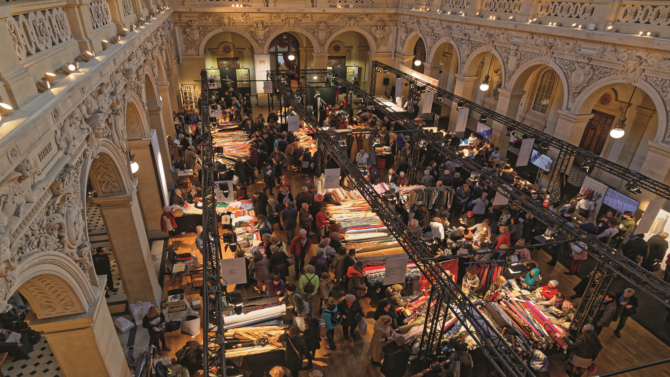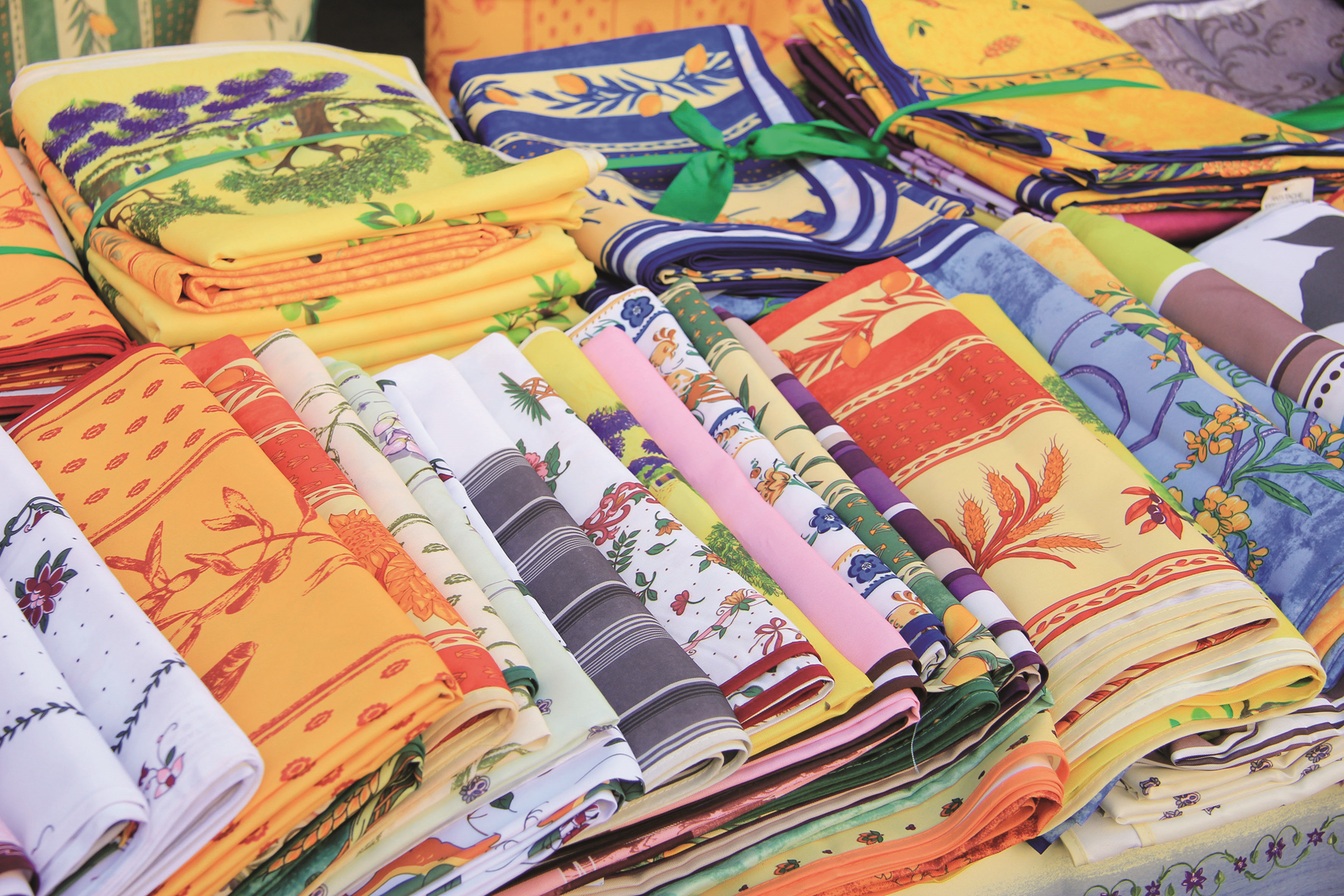France’s Fabrics: Toile de Jouy, Denim & more

It was Coco Chanel, of the eponymous braided, fringed tweed jackets offset with gorgeous gold buttons and chains, who said: “Fashions change, style endures.”
Using the best of materials, coupled with immaculate tailoring, her classic style continues as a fashion staple – not least with the LBD (little black dress). Black, once a colour of mourning, became, under her influence, a staple of everyone’s wardrobe. Chanel introduced the idea of casual chic, liberating women to be comfortable in their clothing. Even before the 1920s started to roar, she brought in simpler shapes, shorter skirts, blurring masculine/feminine codes of styling and tailoring, such as wide-leg trousers and pyjamas designed to wear both on the beach and in the evening for elegant soirées. Perhaps the most enduring staple today, one in every woman’s wardrobe and most men’s, is the marinière jumper. It was over a century ago, in 1917, when she introduced the French matelot jersey as a wardrobe essential. Considered shocking at the time, today everyone from the Princess of Wales and Brigitte Bardot to Kate Middleton and Gwyneth Paltrow have been seen wearing this most comfortable and enduring of classics. Inspired by the striped jumpers worn by the French navy, these traditional jerseys are still produced in Finistère and Morbihan and promoted by the likes of Jean Paul Gautier, although his uses for matelot stripes are somewhat more outré it has to be said!
While talking stripes, it would be rude not to mention striped espadrilles. Traditionally canvas shoes with rope soles, the best are made with Basque linen and textiles from St-Jean-de-Luz to Espelette – rainbows on your feet and so comfortable on hot summer days!
France has always been known for the quality of its fabric: the production of silk was first recorded in France in the 11th century. However, silkworm breeding and silk production started in earnest in the Cévennes in southern France by the end of the 13th century. In 1466, Louis XI decided to develop a national silk industry in Lyon to reduce France’s trade deficit with Italian states who were producing costly and luscious silk materials, the must-haves of their day for dedicated followers of fashion.
By the 16th century, Lyon had become the capital of the European silk trade abandoning Oriental designs to create their own distinctive French style emphasising landscapes – was this the birth of true French styling? By the early 19th century, the Napoleonic era gave new impetus to the silk business, as did the invention of the Jacquard loom where decorative patterns were introduced into cloth. For some reason I always think of lace in conjunction with silk, and France produces some of the most exquisite. In Alençon, production began in the 16th century; once again the French king stepped in to create local industry and reduce the court’s dependence upon costly foreign imports.
Alençon became known as the ‘queen of lace’ and many a portrait features kings, queens and nobles ‘decorated’ with this beautiful (and costly) embellishment. With its mesh ground and raised outlines set around patterned motifs, it’s perfect for adorning a wedding or ball dress – especially one made from Lyonnais silk. Around Calais, a similar industry emerged in the 19th century when English lace-makers smuggled a new- fangled loom into France to set up shop at nearby St-Pierre. It remains an important centre for machine lace production, much sought after by designers such as Valentino, Lacroix and Calvin Klein for wedding dresses and lingerie.
The Lyonnais continued to develop their clothmaking industry. Today automatic looms and new weaving techniques are used to create fabric with other fibres, while its highly skilled specialists work in the restoration of historic fabrics and supplying haute couture designers.
Speaking of which, it’s said that haute couture in France began in the 17th century when Rose Bertin, fashion designer for Marie Antoinette, was credited for bringing fashion to French culture when she ran up a number or three for the queen to parade around Versailles and le Petit Trianon.
ALL IN THE DETAIL
By the mid-19th century, Paris became the centre of a growing industry focused upon making outfits from expensive, high- quality, often unusual, fabric sewn with extreme attention to detail. Visitors brought back clothing to be copied ‘back home’ by local dressmakers. French fitters and dressmakers were considered the best and real Parisian garments to be better than local imitations. As travel became easier with the advent of steamships and railways, wealthy women, such as the ‘dollar princesses’ bringing money to prop up impoverished aristocrats’ estates, travelled to Paris to shop for their trousseau, clothing and accessories.
Here enters Englishman Charles Frederick Worth, considered the father of haute couture. He revolutionised how dressmaking had been perceived by turning design into an art form. In Paris he not only created bespoke designs for his wealthy, probably titled, clients but also prepared a portfolio of designs that were soon became known as ‘jeans’. ‘Denim’ came in when French weavers combined wool and silk, both produced locally, to create ‘toile de Nimes‘ another hardwearing material that in turn became known as denim. Recognising a nice little earner, Nimes merchants saw their cloth as having huge potential and started exporting it by the tonne to England knocking Genoa’s trade for six. Of course, later on a chap named Levi Strauss came along – but thanks to those merchants it’s still called denim.
SUNSHINE STYLE

Provencal fabric, Photo: Shutterstock
Using southern France as inspiration, Provençal fabric seems to reflect sunshine and vibrant colours, a reminder of sun-drenched holidays under clear blue skies with local produce like lavender and olives thrown into the mix. However, these gorgeous fabrics didn’t originate in Provence, they were imported from India and Persia. Known as Indiennes, the printed fabrics first arrived through the busy port of Marseille becoming an immediate hit, so much so that their popularity led to the decline of the local silk and woollen industries until a silkmakers’ lobby in the 17th-century convinced the king to ban their imports and manufacture in France. So, their makers simply moved to Avignon, then a papal state, and there they remain. Echoing the countryside, the fabric evolved. Colourful stripes are mixed with flowers and fruits in patterns and each region seems to have a specific pattern such as Carpentras, Côte d’Azur and Lubéron. Still manufactured here, you can visit Souleiado, Les Indiennes de Nimes and Les Olivades in St-Étienne-du-Grès and become dedicated followers of Provençal fashion!
Joanna Leggett is the Marketing Director at Leggett Immobilier.
Tel: 08700 11 51 51 (UK) 0033, (0)5 53 60 84 88 (INT)
Looking for more French property advice?
The unique mix of legal, financial and tax advice along with in-depth location guides, inspiring real life stories, the best properties on the market, entertaining regular pages and the latest property news and market reports makes French Property News magazine a must-buy publication for anyone serious about buying and owning a property in France.
Lead photo credit : Silk in Lyon, Photo: Shutterstcok
Share to: Facebook Twitter LinkedIn Email
More in fabrics, France, Lyon, materials



